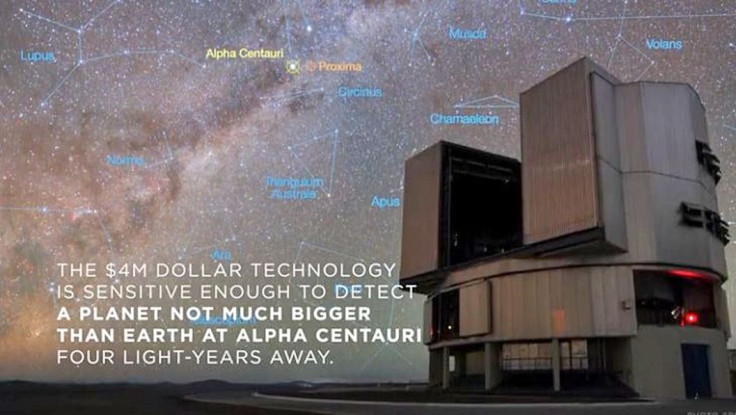Scientists Use New Instrument To Hunt For Alien Life In Alpha Centauri

The European Southern Observatory (ESO) has commenced an intensified hunt for exoplanets in the habitable zones in the solar system nearest to our own.
Leading this renewed effort to find alien life in Alpha Centauri, which is only 4.37 light-years or 1.34 parsecs from the Sun, is a new instrument called NEAR (Near Earths in the AlphaCen Region).
Alpha Centauri is a star system consisting of three stars: α Centauri A (officially Rigil Kentaurus), α Centauri B (Toliman) and α Centauri C (Proxima Centauri, which is a red dwarf star). Current knowledge about Alpha Centauri’s planetary systems remains limited.
Technically a thermal infrared coronagraph, NEAR is designed to hunt for exoplanets in Alpha Centauri within the habitable zones of its two Sun-like stars, Rigil Kentaurus and Toliman, where water might potentially exist in liquid form.
Developed over the last three years, NEAR was built by the University of Liège in Belgium, the University of Uppsala in Sweden, California Institute of Technology in the U.S. and Kampf Telescope Optics in Munich, Germany.
Breakthrough Watch, the global astronomical program looking for Earth-like planets around nearby stars, and ESO, Europe’s foremost intergovernmental astronomical organization, on Monday announced the “first light” for NEAR, which is housed at ESO’s Very Large Telescope in the Atacama desert in Chile.
The Alpha Centauri exoplanets, which are twice the size of Earth or bigger, can be detected by NEAR. This instrument’s near- to thermal-infrared range is significant since it corresponds to the heat emitted by a candidate planet. This will enable astronomers to determine if the planet’s temperature allows for the existence of liquid water.
NEAR is the first and the only project that can directly image a habitable exoplanet. It marks an important milestone in humankind’s search for extraterrestrial life.
In 2016, a team using ESO instruments discovered an Earth-like planet orbiting Proxima Centauri. But Rigil Kentaurus and Toliman remain unknown and it’s not clear how stable such binary star systems are for Earth-like planets.
Astronomers concur the most promising way to establish whether Earth-like planets exist around these nearby stars is to attempt to directly observe them.
Imaging such planets remains a major technical challenge, however. Starlight that reflects off Earth-like planets is generally billions of times dimmer than the light we see from their host stars.
Resolving a small planet close to its star at a distance of several light years is akin to spotting a moth circling a street lamp dozens of miles away. To solve this problem, Breakthrough Watch and ESO in 2016 together built a special instrument called a thermal infrared coronagraph.
This type of coronagraph is designed to block out most of the light coming from a star and is optimized to capture the infrared light emitted by the warm surface of an orbiting planet, rather than the small amount of starlight it reflects.

The coronagraph has been installed on one of the VLT’s four 8 meter-aperture telescopes. It upgrades an existing instrument called VISIR and thereby optimizes its sensitivity to infrared wavelengths associated with potentially habitable exoplanets.
It will be able to search for heat signatures similar to that of the Earth, which absorbs energy from the Sun and emits it in the thermal infrared wavelength range.
“We’re delighted to collaborate with the ESO in designing, building, installing and now using this innovative new instrument,” said Pete Worden, Executive Director of the Breakthrough Initiatives.
“If there are Earth-like planets around Alpha Centauri A and B, that’s huge news for everyone on our planet.”
ESO project manager Robin Arsenault said ESO is glad to bring its expertise, infrastructure and observing time on the Very Large Telescope to the NEAR project. The NEAR experiment is also a pathfinder for future planet-hunting instruments for the upcoming Extremely Large Telescope.
Published by Medicaldaily.com



























